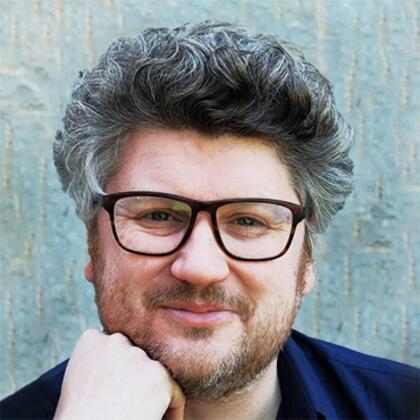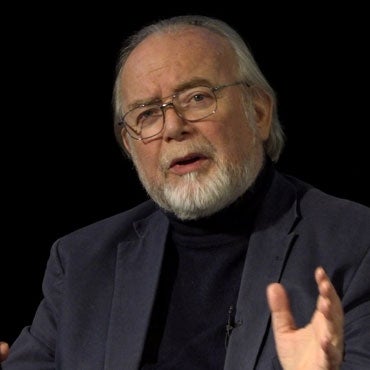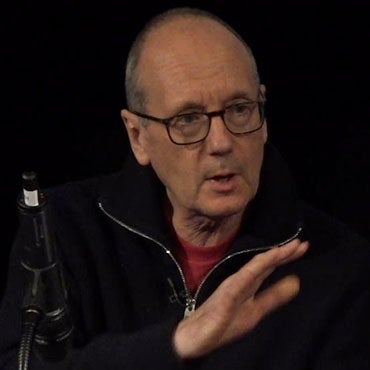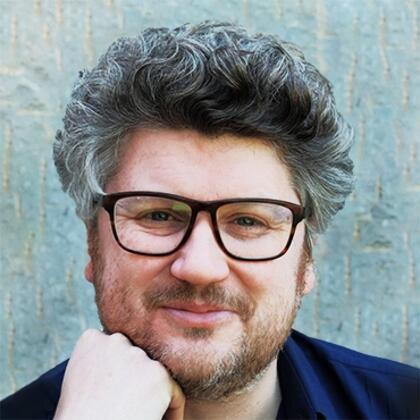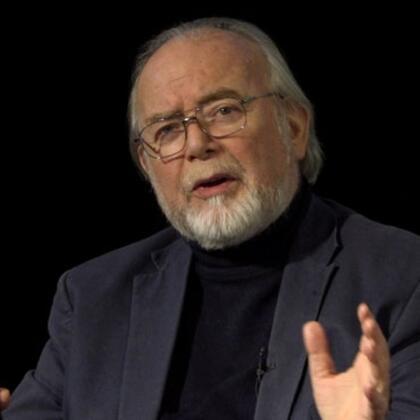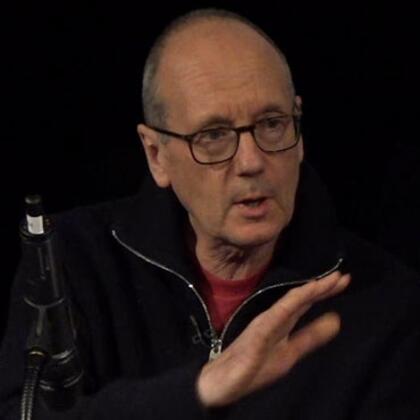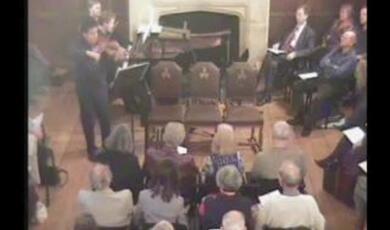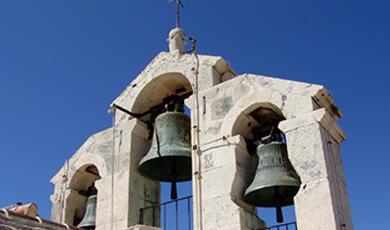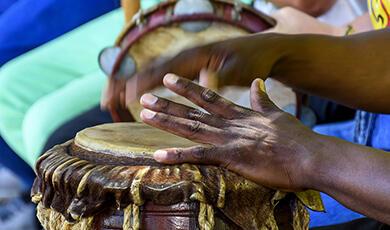Sacred Listening: The Voices and Music of the Gods
Share
- Details
- Text
- Audio
- Downloads
- Extra Reading
What happens when we listen to music that incarnates a divine presence? From our early ancestors, whose listening in the caves of Europe 40 millennia ago opened up gateways to other worlds, sacred places have developed special acoustics for spiritual encounters across religious traditions from Buddhism to Christianity. That means special modes of listening, and unique musical repertoires: simultaneously directed outwards, towards the heavens, and inwards, sounding out the spaces that are sometimes called souls.
Download Text
14 JANUARY 2019
Sacred listening: the voices and music of the gods
Professor Tom Service
We’re on a journey today: inwards to the echoes of our own listening, in which we find through a combination of archaeological and theological enchantment. A story of our encounters with the sacred: and we will find that the bridge to sacred experience has come, and still comes, through one sense above all: listening, vibration perception, hearing. Ludwig Feuerbach - who claimed the death of God in the 19th century - might seem an unlikely proselytizer of the idea of hearing as a bridge to a sacred enchantment, but here’s what he said in The Essence of Religion in 1845
“If man had only eyes, hands, and the sense of taste and smell, he would have no religion, for all these senses are organs of critique and skepticism. The only sense which, losing itself in the labyrinth of the ear, strays into the spirit or spook realm of the past and future, the only fearful, mystical, and pious sense, is that of hearing”
I love that - the spirit or spook realm: Feuerbach’s historical materialist post-enlightenment project wanted to unmask the smoke and mirrors of religious experience precisely through the skepticism and criticism of the other senses, but his is a crucial revelation of the way that hearing takes us to those other places of our experience which we call religious, spiritual, or transcendent, whether in shamanistic ritual, cantillation, or communal religiosity.
Tibetan temple rituals, Siberian shamanic music, Jewish Cantillation and Christian hymns - sounds of the sacred from religious cultures around us in the world today.
But for much of the rest of this evening, we’re going back in time and across cultures to find earlier echoes of the ways that sound and music have activated divine and uncanny presences - to discover how ancient cultures invoked the sacred through sophisticated manipulation of acoustics, architecture, and cosmology, thanks to the research and work of Paul Devereux - who I’m delighted is with us this evening. And later, the composer, improviser, and author David Toop - who’s written books from Ocean of Sound to Sinister Resonance - will create a seance of the uncanny for us right here at the Museum of London, bringing the spirits of inanimate objects to life right in front of our eyes and ears.
As David puts it in the revelatory pages of, Sinister Resonance: The Mediumship of the Listener, echoing Feuerbach - and going further:
“Sound is void, fear, and wonder. Listening, as if to the dead, like a medium who deals only in history and what is lost, the ear attunes itself to distant signals, eavesdropping on ghosts and their chatter. Unable to write a solid history, the listener accedes to the slippage of time”.
And that’s the experiential knife-edge we’re on tonight: the reason that music is such a powerful component of so many religious experiences is to do with the imminently uncanny properties of sound: the way that sound exists in the air, in the ether; that it can be heard to emanate from all around us, from sources that are seen and unseen; the way that it can reverberate in spaces as a disembodied presence, and the way that sound waves can create strange and wonderful physical phenomena.
Reverend Lucy Winkett has another gloss on the paradoxical presence and disembodied absence of both sound and the voice of God in her beautiful book, Our Sound is Our Wound:
“Because we can’t see sound, and God is invisible, the world of sound [is] a rich source of metaphoric descriptions of the presence and activity of God … God has a voice, but no one seriously believes that this means God has a larynx”.
As we’ll find out, the sacred in music, is also a story of the spooky, the uncanny, even, the occult: throughout the centuries, over the millennia, and right here in the Museum of London this evening!
But let’s start by inviting Paul Devereux on stage: Paul is one of the founders and leaders of archaeoacoustics, and has accomplished decades of research into the soundworlds, the acoustics and the potential meaning of ancient sites all over the world, from ringing stones on the west coast of Scotland, to the Kings’ Chamber of the Great Pyramid, to the Hypogeum in Malta: Paul’s going to introduce us all to some great secrets of the sounds of the sacred, as revealed by his work.
[Paul Devereux presentation, covering the following]
1)Measuring resonance in megalithic chambered structures, where he found a recurring acoustic frequency that caused regional brainchanges.
2)Ringing rocks/lithophones, including his Royal College of Art research uncovering the soundscape at the Preseli, Wales, originarea of the Stonehenge bluestones.
3)His discovery in 2007 that the Neolithic ceiling painting in the Hal Saflieni 'oracle chamber' was acoustical notation.
Paul, thank you: revelation on revelation: journeys inside our history, and inside our bodies: you feel that these spaces were made in order to activate the resonant frequencies of our bodies: so that the real vessels of and for the sounds of the sacred are the contexts and creations of our own bodily listening.
I just want to go back to the scepticism of Feuerbach for a minute: because there were later traditions in which the sounds of the voice of God and Gods were hear: like the Oracle at Delphi, used by the Greeks for a millennium and more, from the 8th century BC to the 4th AD. Here’s a 19th century vision of how the Pythia might have spoken to her subjects after their peregrination to the Temple.
There are long and ongoing traditions of speaking in tongues, across religious traditions from Christianity to shamanism, but in the 18th century, the appearance of voices of God, these sounds of the uncanny, whether in the form of speaking statues, or the kinds of acoustic revelation that Paul has told us about - and that David Toop will release into the atmosphere for us later on here at the Museum of London! - were liable to be seen as infernal machines of pseudo-religious deception, awaiting the enlightenment of rationalism for their explanation, so that these false Gods of pagan traditions could be cast out. It’s a story told in great and wonderful detail by Leigh Eric Schmidt in his book Hearing Things: Religion, Illusion, and the American Enlightenment.
Here’s how Fontenelle sees the true light of Christianity casting out the pagan voices of the old Gods - the demons disappear in vapours from the mouths of the pagans, thanks to the beam of light from the crucifix. And in the same book, other images show how the great deceptions of the Voice of the Gods of pagan traditions were carried out: through statues that spoke not because of divine presences, but hidden speakers - speaking people! - in recesses under the floor.
That kind of illusion became a commonplace in the 19th century when variety acts made use of the Acoustic Temple illusion, with concealed tubes plumbed into vaulted spaces so that a hapless participant could imagine they were hearing the voice of the beyond, when it was actually somebody talking in the next room.
The German thinker Athanasius Kircher had already showed how these technologies might work in the late 17th century: as large speakers carry sound to the mouths of sculptures who would seemingly “speak” to passers-by… Kircher also dreamt of massive speaking trumpets to carry the Christian call to prayer over miles of German countryside.
The illusions of the Voice of God unmasked: silenced by centuries of rationality and reason. Instead of the romantic idea of visionary encounters, by the end of the 19th century, scepticism had really set in. If you set out to hear the voice of God, or perhaps, to have your questions answered by the Sphinx, this would be your fate, as Elihu Vedder depicted it in the late 19th century… This one’s even better: an older man, waiting his whole life to hear… nothing…
Asking inanimate objects for divine intervention - well we don’t do that any more, do we, as good rational, post-Enlightenment beings? Or do we? In fact, we ask oracular questions of inanimate objects for guidance in our lives billions of times every day - this difference is that these mysterious voices respond instantly to us…
[Picture of Amazon Echo Device]
But we don’t need to attempt to invoke the voice of God from inanimate objects when we have God’s words, listening, and music: when we make God’s words our own, through our declamation, chanting, and singing.
Here’s Ibn al’Arabi, a medieval Sufi mystic:
“The first thing we knew from God and which became connected to us from Him was His Speech and our listening… Therefore all the messengers came with Speech, such as the Koran, the Torah, the Gospels, and Psalms, and the Scriptures. There is nothing but speech and listening. There can be nothing else. Were it not for Speech, we would not know what the Desirer desires from us…We move about in listening.”
And the point is, for all the nearly infinite diversity of religious musics and rituals all over the world, there is one feature that does seem common to many religious traditions: our voices… singing or intoning a single, often simple melodic shape or contour, as we commit religious texts to memory through the sounding mechanisms of our bodies chant: from Buddhism, to calls to prayer, to Hebrew cantillation, species of chant is common to religious cultures the world over.
But let’s focus, for now, on chant in the early Christian church. Chant was how the liturgy and the scripture was disseminated - and how it was learnt by priests: the early church was full of singers - it had to be so that the church’s texts and teachings could be spread as widely as possible. This is music made from the earliest Christian repertory that we have in the West: the Ambrosian chant of the Bishop of Milan - created by St Ambrose - in the 4th century; sounds that we’re now hearing recreated by the singers of Ensemble Organum…
[Recording of Paravi lucernam]
The form of these chants is a simple call and response: a single voice intones a melody, which is then taken on in the tune and text of the choir of monks, singing a single unadorned and unharmonised line, which would reverberate through the spaces of the 4th and 5th century church buildings, with their vaulted ceilings and architecture designed to humble the human and glorify the godly in creating a sense of spatial vastness, a resonating chamber for this awesome music to reverberate…
Paravi lucernam Christo meo: I have prepared a lamp for my Christ...
This kind of chant Develops into the repertory we call Gregorian chant, after Pope Gregory the First, who made major efforts - back in the 6th century - to compile the chants according to the services of the Roman Catholic liturgical year. This repertoire of chants is still sung today; they were written down and codified with ever greater precision as musical developed as a literary as well as sonic language throughout the later first millennium. And here’s what it sounds like…
[Recording of Gregorian Chant]
Single musical lines formed the basis of how the liturgy sounded within the ever-grander churches that were built all over Europe - buildings that were early Christian versions of the temples like Hal Saflieni, or Newgrange - places for the resonance of the spirit, for the uncanny projection of the human voice into the infinite. The move is outwards and upwards rather than inwards and downwards as it is in caves, as it is in those Neolithic sites that Paul introduced us to; but the effect of transcendence is the same. This music was sent into the world, broadcast by scribes and monks; these singers and songs simultaneously sacralising the sounds of their voices - and the development of an ever-more sophisticated aesthetics of music: through the techniques that singers and composers could use to beautify the words…
The question is: faced with all of the musical possibilities that there were in the first millennium - instruments, choirs, percussion instruments - why was this medium - voices arcing in the unfurling contours of single melodies of gloriously unpredictable shapes and ornaments - the musical space in which the divine was praised?
It’s because of the text, and it’s because when we sing, we’re embodying the word of God, as Ibn al’Arabi has said. And in specifically Christian contexts, chant like this is performing a multi-dimensional alchemy in the transformation of the musical into the sacramental, as Jeremy Lewellyn of the University of Oxford has suggested: when we sing, we’re participating in a praise that is eternal and heavenly - joining with the angels, singing in the face of God - and with everyone who has gone before us. When we sing - or when we hear this singing - we’re enacting, performatively, that angelic praise.
We’re also singing because we’re encountering a divine presence for which mere language fails: for all that this chant is about the communication of these texts, it’s also about the creation of experiences that are simply too large to be put into words. Singing, even in a Christian context, is about a connection with those other worlds of resonance, familiar to us from those neolithic sites.
Yet there is a specifically literary aspect to the power of these chants too - and not only in Christianity, but in Buddhist sutras, in Hebrew cantillation: the embodied experience of singing - and especially singing in acoustics in which our voice is heard as bigger than itself, through echo and reverberation - helps us memorise these texts, so that to sing these chants is to perform the fundamentals of the religious and sacred life: to be changed by the experience, to be resonated into a better state of religious devotion. Transformation through amplified resonance - one of the secrets of the sacred in sound, as we’ve heard from Paul Devereux, and will again from David Toop!
But these transcendences wrought by music are a problem for many religions. Because if sound itself - on its own, without words, is capable of inducing a state of sensual or even consciousness-altering transformation - then music could be as dangerous as it is useful for religious practice.
It boils down to this: if you’re getting off on the music rather than paying attention to the words, you’re missing the message of being a better religious observant and simply enjoying the pleasures of the music too much.
That’s the reason that so many religions have had ambivalent relationships with music: should instruments be allowed in churches or temples? What scales and modes are appropriate for sacred contemplation - and which aren’t? Should any music at all be heard in a place of worship? One of the first to voice their concerns, and turn his musicophilia into a major crisis of his moral compass, was Saint Augustine in North Africa, at the end of the 4th century… here he is, in his Confessions, his spiritual autobiography:
Saint Augustine: [his Confessions - at end of 4th century, 397-398 - Numidia (north africa)]
50. Thus I fluctuate between peril of pleasure and approved wholesomeness; inclined … to approve of the usage of singing in the church; that by the delight of the ears, weaker minds may rise to the feeling of devotion. Yet when it befalls me to be more moved with the voice than the words sung, I confess to have sinned penally, and then had rather not hear music. … Thou, O Lord my God, hearken; behold, and see, and have mercy, and heal me, Thou, in whose presence I have become a problem to myself; and that is my infirmity.
St Augustine would definitely have had a problem with the music I’m going to play you now. It’s a late 12th century example of music’s enchanted powers of the sacred. By the way, that’s what music is - an en-chant ment - a magic made by singing, by playing, by chanting!... and it’s what this music does: this is piece of organum quadruplum from the Magnus Liber Organi collection at Notre-Dame Cathedral in Paris.
That just means it’s a piece for 4 voices, and it’s by Perotin, one of the masters of the tradition of vocal polyphony. And it is music that would give St Augustine the biggest moral quandary he could have imagined, if he’d lived for another 800 years or so: this is ecstatic, outrageously beautified, virtuosically pleasurable music setting a text that says: All the ends of the earth have seen
the salvation of our God.
Rejoice in the Lord, all lands:
Viderunt omnes fines terræ
salutare Dei nostri.
Jubilate Deo, omnis terra.
Not that you know that until a long way through this piece, because when it starts: all you hear is the Vi - of viderunt…
It takes Theatre of Voices’ singers 50 seconds to get to the second syllable! - ‘de’ - such is the joyful dazzle and sensual complexity of Perotin’s music. It’s a piece that isn’t about setting these words, but about turning them into experience: our attention is pleasurably suspended in the stopped time of those 50 seconds on a single syllable - 3 and a half minutes for the first two words, viderunt omnes - as the sense of the words, the liturgical meaning, is completely subsumed in the vocal-musical pleasure of these voices… Time stops, and we watch and hear the music unfurl in front of us, ever more beautiful, ever more extravagant, especially in the super-resonant cathedral from which it was written, music that becomes a ethereal flight of spiritual fantasy in the air! - meaning is sacrificed here at the altar of musical beautification. I can sense St Augustine’s moral displeasure, 1700 years later.
But in flying free from the words, Perotin gets closer to their meaning, since this music realises a sense of rejoicing more joyously, more completely than simply singing the chant melodies could do.
[music fades]
Mind you, that’s how the piece ends, with the whole viderunt omnes text in unadorned chant; as Perotin reveals the words that have inspired this musical overabundance, this sound of the rejoicing of all lands all over the world in God’s salvation.
Viderunt omnes is just one of the countless proofs of the ties that bind the musical to the sacred: that when our souls are full of faith, we need to sing; and when we are full of music - as performers, as listeners - there is a presence which is tangibly there, but which is as ethereal and difficult to define but simple to feel, as the presence that any religious person would call divine. This is the enchantment of music and the sacred… We are - enchanted…
A final example, before I ask David Toop on stage to prepare us for his own uncanny sonic enchantments: because while the development of Christian worship is often about creating spaces for divine encounters that come from above, in which the divine is seen and heard as external to our bodily experience, which we receive from on high: in fact, the trajectory is really as internal as those resonating encounters in neolithic sites. And it’s our singing bodies that do it - as the story of Bach’s St John Passion at the Proms a couple of years ago shows us.
Bach’s whole achievement builds on Martin Luther’s reforms, and among Luther’s his most revolutionary ideas was his use of music. For Luther, music - especially the easy-to-learn tunes he wrote, chorale and hymn melodies were mapped onto words that would reveal and inspire religious devotion and imitation. And above all; these melodies were meant for everyone to sing. Not least because they were based on folk tunes and farming work songs as well as Gregorian chants, which Luther cunningly brought into his church: the idea was that with the accompaniment of a guitar - there are pictures of Luther himself doing just that - in the home or the pub, or with an organ at church, by singing these melodies with the rest of your community, you would be brought into the new church by the collective power and experience of song, so that there would be no difference between the communality of singing and the experience of religious togetherness and transcendence.
From the 1720s on in Leipzig, Bach’s Passions were performed at Easter Time in Bach’s Thomaskirche in Leipzig, and the Passions were part of a bigger liturgical service; they weren’t performed as stand-alone pieces, whatever their monumental scale - they last 2 or 3 hours as it is, but they were always part of a larger worship. The Passions use Luther’s - and others’ - chorale-tunes, melodies that the congregation would have known, and could have sung. The chorales said to their audience: we’re in this together; this is your story; this story is happening now. There are many other compositional levels in the passions, the arias and choruses and recitative that Bach composes, but the chorales are central to the way these pieces work and what they mean.
At the the 2017 Proms, John Butt and the Dunedin Consort performed the St John Passion. And they weren’t alone. Their performance turned the Royal Albert Hall into a renewed cave for transcendental listening: and the mediums for this experience weren’t only the performers on stage, but the performers in the audience: Butt turned the whole Proms audience into congregational participants in the progress of the Passion: they - we - sang the chorales at the beginning and end of the Passion experience, complete with the congregational singing and chorale preluding from the organist: replicating, as much as possible, not only the order of service as it might have been in the 1720s in Leipzig, but the experience of joining together to witness and create the Passion story.
It was an experience that returned and re-sacralised music that many now think of as made for concert halls: but the Passions were originally and essentially made for liturgical usefulness. The materials and the modes of musicking that Bach uses are even richer than those of Perotin - orchestra, choir, soloists, as you can see - St Augustine would be in a vexed apoplexy! - but the sense of embodied experience, religious experience turned into enacted, performed experience by us in the congregation - listeners no more, but participants! - is the same.
And thanks to Luther’s reforms, and to Bach’s mixing of these modes of composition and participation - as John Butt has explained in his brilliant book, Bach’s Dialogue with Modernity - there’s a continuum of listening participation and compositional virtuosity going on in the Passion, from the harmonisations of the communal chorales to the artistry of the icons for listening of the solo numbers and the choruses, to the raw drama of the Evangelist’s recitative and word-setting, and the quasi-operatic interventions of the choir - we are implicated in the story in the audience on multiple levels. We are involved. We participate not only in listening to the story - but in its unfolding. We are asked to question our own place in the Passion: as the sympathisers and deniers of Christ. Bach’s music belongs to many different times simultaneously: the time of the drama, the abstracted, suspended time that the arias and choruses create, and the present tense of the contemporary, of Leipzig in the early 18th century - and thanks to these performances at the Proms, to our time, to our quotidian present tense too. These chorales, these Lutheran tunes, these fragments of the religious demotic, are bridges to that experience, to our experience.
The impulses of so much Christian worship is to transfer a journey of the spirit in sound that started - in neolithic and Pagan times - as a journey down or inwards to the mystery, so that the resonances of ritual and shamanism and musicking were about turning our bodies into resonant caves in which the divine would be activated; into a journey outwards and upwards, out there the vaulted ceilings of cathedrals, into a mystery of higher than, above us, so that divine experience through music was to touch a world that was not part of us: humanity in worshipful reverence of a presence that was tangibly there, but demonstrably out there, not part of mortal experience, somewhere else, a heaven we can only glimpse from earth, a music that sounds from above.
Well: Bach’s chorales in the Passions - and in the rest of his cantatas - return that experience to our bodies and to the resonance of our voices. Performances like John Butt’s at the Proms - with all those thousands of listener/performers! - are about re-animating the divine within us: we remake the sacred in the image of our own voices, in the resonance we make with each other in the transcended community of our singing. The situation, the context, and the rituals have changed from those places deep in the cave systems and early religious places of worship: but the essence of the experience is the same. We are feeling our voices melt into a bigger and incomprehensible whole: activating that mystic, fearful, and spook sense of hearing to embody the divinity of our own experience, however you want to understand what that means. Through singing, we are making the sacred, just as the voices of our ancestors did too!
https://youtu.be/vPZC5OJhKSU?t=8217
But it’s time now to welcome David Toop on stage here at the Museum of London: Sinister Resonances and Uncanny Echoes made through objects and recordings; and revealing for us how we can journey towards the sacred, the spiritual, the uncanny, through the mediumship of we listeners… David, welcome!
Quotes from Sinister Resonance:
Xi: “There is shuteye, but no shutear”.
Xiv: “Sound is energy unleashed, yet also the perpetual emerging and vanishing, growth and decay of life and death - the perfect metaphor for a ghost”.
Xv: “The intangibility of sound is uncanny - a phenomenal presence both in the head, at its point of source and all around - so never entirely distinct from auditory hallucinations. The close listener is like a medium who draws out substance from that which is not entirely there. Listening, after all, is always a form of eavesdropping”.
… “sound often functions as a metaphor for mystical revelation, instability, forbidden desires, disorder, formlessness, the supernatural, for the breaking of social taboos, the unknown, unconscious and extra-human”.
From Duchamp: “One can look at seeing … one can’t hear hearing”.
© Copyright Tom Service 2018
Part of:
This event was on Mon, 14 Jan 2019
Support Gresham
Gresham College has offered an outstanding education to the public free of charge for over 400 years. Today, Gresham College plays an important role in fostering a love of learning and a greater understanding of ourselves and the world around us. Your donation will help to widen our reach and to broaden our audience, allowing more people to benefit from a high-quality education from some of the brightest minds.


 Login
Login
